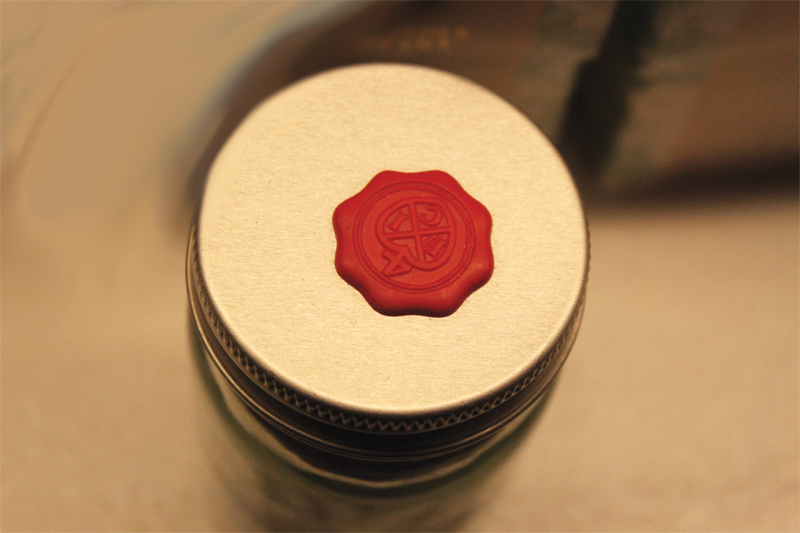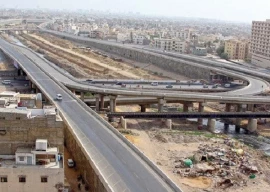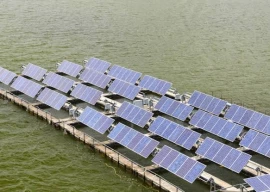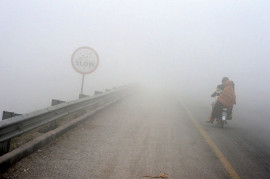

(Below) This artisanal black salt (£10) is produced in natural lava pans with the purest of Hawaiian waters. It owes its rich colour and robust flavour to detoxifying charcoal. Next to it is the Murray Darling salt, extracted from Australia’s longest river and uniquely peach-hued salt (£10). PHOTOS: TOOBA MASOOD
Fifty-year-old businessman Sanjiv Mehta bought the defunct company’s registration in 2005. News of the EIC’s revival made international headlines five years later when he opened its London store, incidentally on the same day the company was shelved 135 years earlier. He told the Financial Times then that, “People are rejoicing because an Indian has bought the EIC — it is a symbol of redemption.”
The EIC emporium is located on Conduit Street, close to the famous toy store Hamleys and a short walk from Oxford Circus. You enter its luxurious crimson and shale interior to encounter wooden caskets and chests spilling over with gourmet delights — the EIC has about 350 luxury food products. Their Poppy cordial, in particular, stands out as a reminder of the vast opium trade that the EIC engaged in to pay for Chinese tea.

For the less naughty there are floral and syrup cordials in the inviting Hibiscus, Violet, Orange Blossom and Mimosa flavours, among others. Tea drinkers can choose from Blend No. 65 pomegranate and lemon, Bombay chai and even Custard Apple ‘Soursop’ leaves, which are just a few of the names. For those with a predilection for hi-tea acrobatics, there is the Thousand Year Red, a green tea bulb woven with the Globe Amaranth Flower which ‘blooms’ when you put it in water.
Each cover of a jar of tea carries the red ‘wax’ seal of the Company’s logo, a heart-shaped figure containing the initials of the company in its three chambers and topped by a figure four. This symbol used to help people identify goods arriving at the ports and was referred to as the ‘chop’, a British linguistic interpretation of our ‘chhaap’ or stamp.
If you aren’t much of a tea drinker please try the Tiger of Mysore Mocha Mysore Espresso Grind (250g). Perhaps some dark chocolate with red peppercorn might interest you? The prices for the gourmet line range from £3.50 for tea to £15 for coffee.

In a completely other league, though, is the EIC’s return to the bullion trade. In 2012 it started remaking coins to target collectors and connoisseurs. Of course, the Company is famous for bringing the word ‘cash’ into circulation (Tamil ‘Kasu’ for coin) and used to make its own currency, starting in 1677. Now you can buy an original 1841 Queen Victoria One Mohur Gold coin. It comes with a letter of authenticity, costs 4,500 pounds and there are only four available. If they are snapped up and you still want to get in on a piece of the action, you may have to wait for the company’s jewellery line which would include pieces inspired by the Mughals.
History and future
The EIC was created on December 31, 1600, via a royal charter by Queen Elizabeth I, the virgin queen, when she gave 200 merchants a monopoly on trade in South Africa. She died within two years. Eight years later, the EIC’s ships landed in Surat.
One of the first men to make contact with the Indian rulers, in this case Emperor Jehangir, was a man called William Hawkins, who spoke fluent Turkish. Details of their encounter are spelled out in Anthony Wild’s splendid book, The East India Company: Trade and Conquest from 1600 (Harper Collins and reprinted by the EIC). Jehangir was so impressed by Hawkins’ ability to speak the language that he found him an Armenian Christian wife and gave him command of 400 cavalry with the title of ‘Khan’ and a huge salary.

(Above) Delicate, flowering teas, such as this rose bud one, gently bloom in hot water to unfold an exquisite bouquet of colours, fragrances and flavours (£10). (Top right) Cordials were famously used throughout the East to add an essence to water or tea and even to flavour sweets. The EIC has eight flavours each bottle priced at £7.95. (Inset) The EIC’s new owner Sanjiv Mehta. PHOTO: BBC
The EIC’s focus was spices but it soon caught up with the textile trade which involved cloth such as calico, chintz, muslin and raw silk. What we know today as the famous ‘British’ floral Chintz pattern is actually ‘Indian’. This fast-dyed cotton emerged in India and the word comes from a Sanskrit word meaning coloured or spotted, according to experts from the Victoria and Albert Museum in London that inherited much of these collections. The textiles from India were famous for their stunning red madder dye and violet-blue indigo.
Textiles became so important that the EIC set up factories in Bombay, Madras and Calcutta, which became the company’s main administrative hubs or “presidencies” and “have since developed into the largest cities of modern India,” as Wild notes.
Lingering post-colonial misgivings aside, it would not be fair to ignore that the EIC was instrumental in changing how the world does business. At one point it conducted and controlled 50% of world trade and its influence extended to one-fifth of the world’s population. The company’s jewel-toned website says, quite aptly: “The East India Company’s employees did not set out to change the world. They were people who set sail to establish trade routes, to discover and bring back new goods, and in doing so broke down the barriers of the world.”

White needle green tea leaves with a vibrant red Globe Aramanth blossoming at its centre for the Thousand Year Red (£10). PHOTO: EICFINEFOODS.COM
Refreshingly, though, the website also says that the people who ran the Company — explorers, traders, innovators — took risks, broke new ground and “sometimes got it wrong”. This indicates that its new managers are not pretending as if the EIC’s history of slavery, colonialism and oppression is something they can simply sweep under the carpet.

A staffer pours a cup of tasting sample. Today, the EIC’s curated tea library offers over 120 varieties.
PHOTO: TOOBA MASOOD
One wrong, for example, was ruling large parts of India from 1757.
But there are many other documented wrongs. When drought struck Bengal in 1769, the Company raised taxes and refused to intervene; as many as seven million died in the resulting famine, reports Nick Robins in his book, The Corporation That Changed the World: How the East India Company Shaped the Modern Multinational (Pluto Press, 2006). Hypocrisy and double-standards are some of the lesser sins. “Tea would become the Company’s commercial swansong,” writes Robins. “But this glamorous trade rested on a deadly secret: its growth was paid for by the mass smuggling of opium from the Company’s Indian territories into China.” And of course, then was the use of force. Its private army took over the bulk of the subcontinent.
In 1757, the EIC’s private army defeated the Nawab of Bengal at the Battle of Plassey. A puppet ruler was installed and this was the turning point at which historians have generally felt the British Empire in India was created. Its end was marked by an uprising in 1857-58, which we know as the First War of Independence in India. On June 1, 1874, the company ceased to exist.

In the East India Company’s London flagship store hundreds of luxury food products are on display, from condiments to coffee. You can buy them online at eicfinefoods.com. PHOTO: TOOBA MASOOD.
It is safe to say that reviving the company 144 years later probably doesn’t open any wounds. But given its pivotal role in shaping the trajectory of India and Pakistan, do people react badly to bringing it back? Sanjiv Mehta told the BBC that he had received 15,000 emails of support from Indians. And while we no longer live in a time when companies can take over countries, as I left the emporium with a small blue tin box (which was all I could afford), I couldn’t help but muse: imagine the East India Company ruling England today.
FUN FACTS
1. The benefactor after whom Yale University is named, Elihu Yale, worked at The East India Company and worked his way up to become governor of Fort Saint George, Company’s installation at Madras.
2. In 2008, the UK scrapped laws on the East India Company because it had shut during the 19th Century.
3. The city of Singapore was established by the EIC.
4. Words like calico, dungarees, gingham, khaki, pyjama, sash, seersucker, shawl, are all Indian-inspired because of the EIC trade. It also involved nainsooks, sassergates, alliballies, humhums, jamdanies.
5. Charles II had acquired Bombay which he leased to the EIC in 1668 for an annual rent of 10 pounds. Its name comes from the Portuguese ‘Bom Bahia’ or beautiful bay.
6. By 1857, the EIC had 43 warships and 273 European officers.
7. Punch was a favourite with the Company’s employees in India. The word is from the Hindi/Urdu ‘Panch’ meaning five. This refers to the five ingredients then used in the drink: tea, arrack, sugar, lemons and water.
8. The word factory originally meant an East India Company trading station. The word factory comes from factor: A factor was a Company buyer/seller. Staff were promoted by grades: writer, factor, junior and senior merchant.
9. The word ‘Posh’ comes from ‘Port Outward Starboard Home’. It originated in the days of The East India Company’s ships departing from the UK for the Indian Ocean. The Port or left side of the ship’s cabins faced east and received the sun (plus the coastal view). The opposite was true on the return trip.
Mahim Maher is an editor at The Express Tribune. She tweets @Mahim_Maher
Images courtesy: The East India Company: Trade and conquest from 1600
Published in The Express Tribune, Sunday Magazine, March 30th, 2014.
COMMENTS (8)
Comments are moderated and generally will be posted if they are on-topic and not abusive.
For more information, please see our Comments FAQ
















1734778885-0/Untitled-(10)1734778885-0-270x192.webp)






Great read Mahim, it was amazing to read the trivia regarding EIC. Thanks for this article.
Best Regards Rishi
Welcome to India , but this time with Indian master . Let Indian businessmen set free , they will roam around London and buy the whole city . Most of the British employees are now on Indian masters' payroll .
Dream on everybody. The East India company of old still exists, but under a different name. It is a huge conglomerate incorporated into the City of London banking system amongst other interests.
Sanjev Metha.........sharp businessman. That was a nice read.
Day is not far when some Indian/ Pakistani will buy London like the way British used to buy cities and provinces. I am sure British will be will to sell Falkland islands and other islands far away from UK if they get good bidders.
He should rename it to East England company.
how the times have changed.
Thanks Mahim Maher. Extremely refreshing read. Felt like sipped one of those teas after reading your well researched work. Thank you!
East Indian Cool !